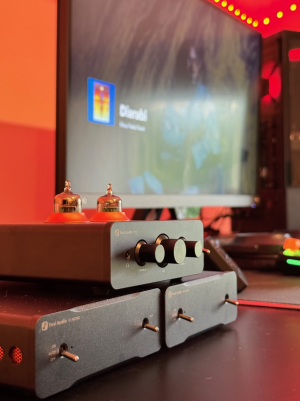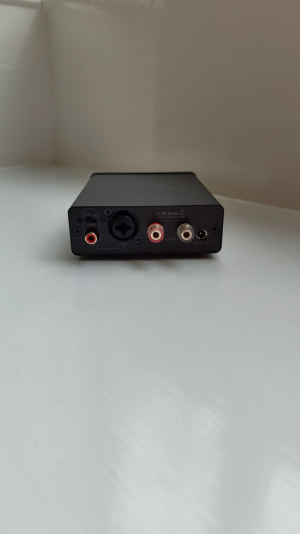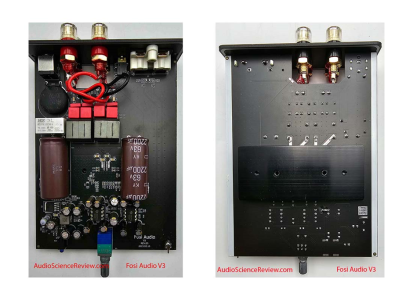NellyNoodle
New member
My review of the Fosi Audio V3 Mono.
I was supplied with these by Fosi and asked for an honest review, so I will promise to give my absolute honesty about this product.
Packaging
The V3 Mono’s came in 2 boxes, each with their own power supply and amplifier, along with some instructions that brush over the basics of monobloc amps. They were securely packaged between two foam plates, which seemed to have done the job as theyre beautiful anodized aluminium body was left unscathed. The box was slightly dented as I received it, but no troubles apart from that.
Product
These amps feature a matte black anodized aluminium body with orange highlights and two silver switches to switch power and input modes. You will need a preamp for these as they are purely power amps, unlike theyre za3 counterparts. I used the Fosi audio p3 preamp which was perfectly adequate pair for the v3’s. these also feature a new “auto” power mode, which aims to save power by putting the amp into standby whenever a signal isnt received for 10 seconds, I found this to work incredibly efficiently, and have mine on auto all the time. So much so that I don’t think I have ever used the exclusive “on” mode…

moving to the back of the amps, there are a total of 5 connections. One RCA input, one XLR input, two RCA outputs, and a DC input to connect your power supply that is provided (48 Volt 5 Amp). These amps were fairly easy to setup and took me a grand total of around 10 minutes to swap into my sound system, each input and output are clearly labelled and make it easy to understand which cables go where. Be aware though that when you connect your pre-amp you make sure to plug the left channel output into the left mono and so on… I made this mistake when first setting them up and it resulted in the audio sounding very distant and muffled… Speaking of which I used banana cables to connect these amps to a pair of bowers and Wilkins 686 bookshelf speakers, and my only query would be that if you were trying to use raw or bare wire, it may be quite hard to get every piece to make contact properly due to the nature of the standoffs used. The standoffs seem slightly cheap and fiddly to me, hence why I went the easy route of using banana cables, which I would recommend for everyone who purchases these. They make the setup process a breeze. I also feel that being able to use an RCA splitter cable would be nice, but due to the RCA in placement on each amp being in the middle, splitter cables are out of the question as they just can’t reach far enough inwards if both amps are being used directly side by side.

I’m sure some people would prefer this as it probably leads to less interference and better audio quality, but I myself am a fan of good or convenient cable management, I felt the need for 2 separate cables instead of 1 splitter a slight faff… speaking of inputs and outputs, these amps also house a small gain switch in the top right corner of each amp with the options for 25 or 31 decibel gain. I personally used the 25DB as I’m using bookshelf speakers and anything past 50% of volume with the P3 was unbearable, although if you were listening on a pair of decent floor standing speakers, I would highly advise you use the 32DB of gain to make the most out of them.
Touching on the insides and components of these amps, I myself didn’t get a chance to open one up as I was scared I’d break something, but I know others have so I will provide a photo below.

credit to audiosciencereviews.com for the above images.
I am aware that premium components such as Wiima capacitors are used to produce a refined warm sound, and I am also aware of the chip used, which is a Texas Instruments TPA3255. Another premium component that cannot go unnoticed, Texas instruments never fail to produce a wonderful warm but refined sound, that I felt filed the room. These are the first-class B amplifiers where I had felt the music was being performed in front of me instead of through speakers, the sound was incredibly full and pronounced and sounded very close to someone singing just behind my desk. The base was pronounced and precise, treble is full of clarity and vibrance. Whilst I listened to these over the past week, I couldn’t help but realise that Fosi’s PFFB (post filter feedback technology) had been performing wonders, as even when I pushed these amps to their limits, almost zero noise could be heard, and as for the distortion, I can not provide a graph but can tell you that there was little to none and normal listening volumes. Anything around 75% or more on the P3S volume knob started to produce almost impossible to hear amounts of distortion. This contributed to my previous mention of how realistic these amps sound when paired with the correct speakers, as they seemed to make these bookshelf speakers for my desktop setup disappear into the background. Something I havent yet experienced with past class B amps such as the ZA3 and Aiyima AO7 Max.
Conclusion
Overall, I thought these amps to be an incredible addition to my desktop setup, the quality and clarity of the trebles, paired with punchy and precise bass made for an incredibly premium listening experience, even rivalling my other system powered by a linn majik dsm 3 and linn majik 140s, and that’s saying something as that sound system I have had for years, and thought to be brilliant. Yet now I am doubting myself after listening to a pair of class b monoblocs blow me away at my desk.
I would like to thank Fosi Audio very much for sending me these products to test and would recommend these little gems of the class B amp scene to anybody looking for an incredibly compact and powerful setup, as the Fosi Audio V3 Mono’s will not disappoint!
I was supplied with these by Fosi and asked for an honest review, so I will promise to give my absolute honesty about this product.
Packaging
The V3 Mono’s came in 2 boxes, each with their own power supply and amplifier, along with some instructions that brush over the basics of monobloc amps. They were securely packaged between two foam plates, which seemed to have done the job as theyre beautiful anodized aluminium body was left unscathed. The box was slightly dented as I received it, but no troubles apart from that.
Product
These amps feature a matte black anodized aluminium body with orange highlights and two silver switches to switch power and input modes. You will need a preamp for these as they are purely power amps, unlike theyre za3 counterparts. I used the Fosi audio p3 preamp which was perfectly adequate pair for the v3’s. these also feature a new “auto” power mode, which aims to save power by putting the amp into standby whenever a signal isnt received for 10 seconds, I found this to work incredibly efficiently, and have mine on auto all the time. So much so that I don’t think I have ever used the exclusive “on” mode…

moving to the back of the amps, there are a total of 5 connections. One RCA input, one XLR input, two RCA outputs, and a DC input to connect your power supply that is provided (48 Volt 5 Amp). These amps were fairly easy to setup and took me a grand total of around 10 minutes to swap into my sound system, each input and output are clearly labelled and make it easy to understand which cables go where. Be aware though that when you connect your pre-amp you make sure to plug the left channel output into the left mono and so on… I made this mistake when first setting them up and it resulted in the audio sounding very distant and muffled… Speaking of which I used banana cables to connect these amps to a pair of bowers and Wilkins 686 bookshelf speakers, and my only query would be that if you were trying to use raw or bare wire, it may be quite hard to get every piece to make contact properly due to the nature of the standoffs used. The standoffs seem slightly cheap and fiddly to me, hence why I went the easy route of using banana cables, which I would recommend for everyone who purchases these. They make the setup process a breeze. I also feel that being able to use an RCA splitter cable would be nice, but due to the RCA in placement on each amp being in the middle, splitter cables are out of the question as they just can’t reach far enough inwards if both amps are being used directly side by side.

I’m sure some people would prefer this as it probably leads to less interference and better audio quality, but I myself am a fan of good or convenient cable management, I felt the need for 2 separate cables instead of 1 splitter a slight faff… speaking of inputs and outputs, these amps also house a small gain switch in the top right corner of each amp with the options for 25 or 31 decibel gain. I personally used the 25DB as I’m using bookshelf speakers and anything past 50% of volume with the P3 was unbearable, although if you were listening on a pair of decent floor standing speakers, I would highly advise you use the 32DB of gain to make the most out of them.
Touching on the insides and components of these amps, I myself didn’t get a chance to open one up as I was scared I’d break something, but I know others have so I will provide a photo below.

credit to audiosciencereviews.com for the above images.
I am aware that premium components such as Wiima capacitors are used to produce a refined warm sound, and I am also aware of the chip used, which is a Texas Instruments TPA3255. Another premium component that cannot go unnoticed, Texas instruments never fail to produce a wonderful warm but refined sound, that I felt filed the room. These are the first-class B amplifiers where I had felt the music was being performed in front of me instead of through speakers, the sound was incredibly full and pronounced and sounded very close to someone singing just behind my desk. The base was pronounced and precise, treble is full of clarity and vibrance. Whilst I listened to these over the past week, I couldn’t help but realise that Fosi’s PFFB (post filter feedback technology) had been performing wonders, as even when I pushed these amps to their limits, almost zero noise could be heard, and as for the distortion, I can not provide a graph but can tell you that there was little to none and normal listening volumes. Anything around 75% or more on the P3S volume knob started to produce almost impossible to hear amounts of distortion. This contributed to my previous mention of how realistic these amps sound when paired with the correct speakers, as they seemed to make these bookshelf speakers for my desktop setup disappear into the background. Something I havent yet experienced with past class B amps such as the ZA3 and Aiyima AO7 Max.
Conclusion
Overall, I thought these amps to be an incredible addition to my desktop setup, the quality and clarity of the trebles, paired with punchy and precise bass made for an incredibly premium listening experience, even rivalling my other system powered by a linn majik dsm 3 and linn majik 140s, and that’s saying something as that sound system I have had for years, and thought to be brilliant. Yet now I am doubting myself after listening to a pair of class b monoblocs blow me away at my desk.
I would like to thank Fosi Audio very much for sending me these products to test and would recommend these little gems of the class B amp scene to anybody looking for an incredibly compact and powerful setup, as the Fosi Audio V3 Mono’s will not disappoint!

